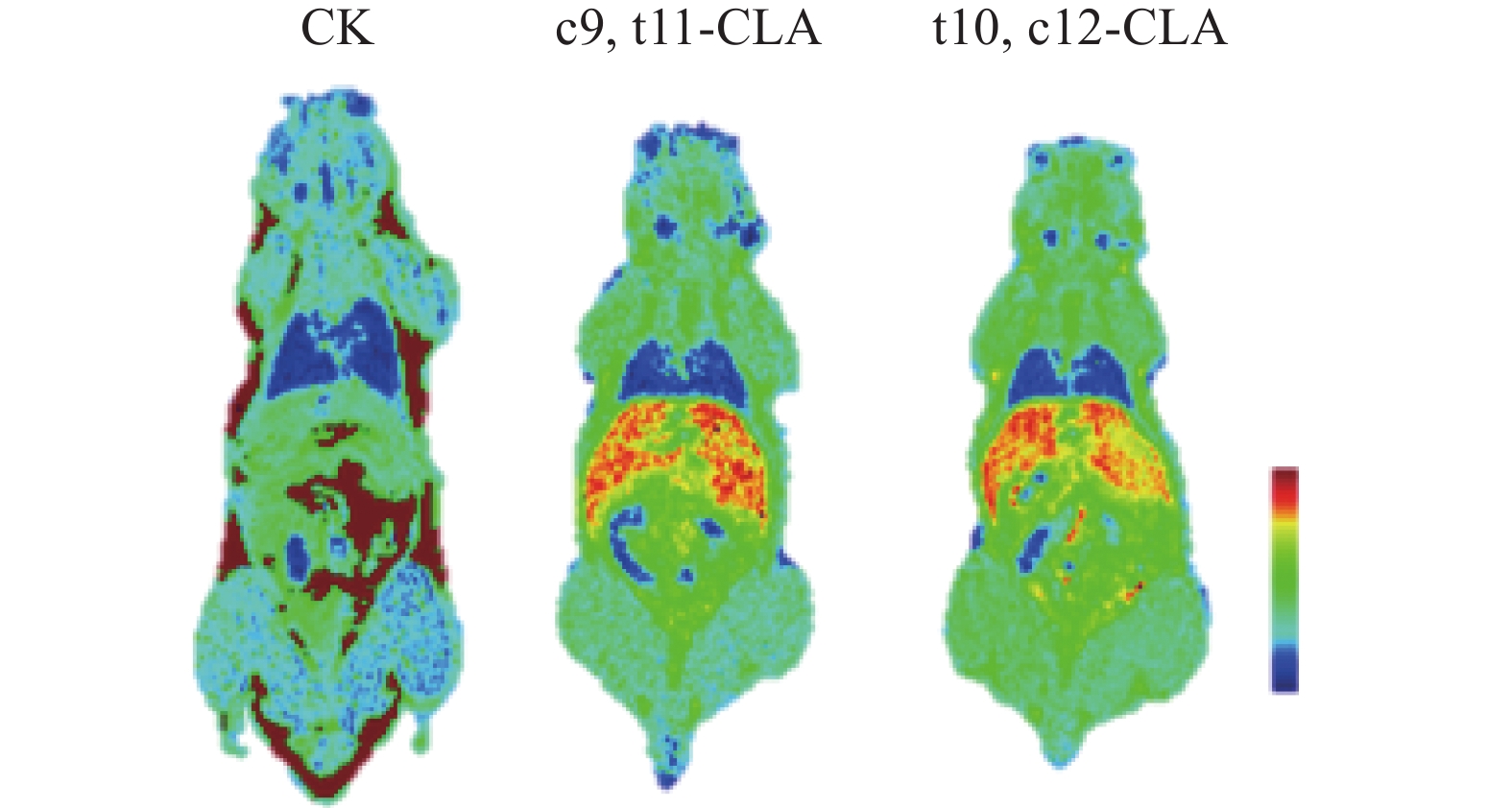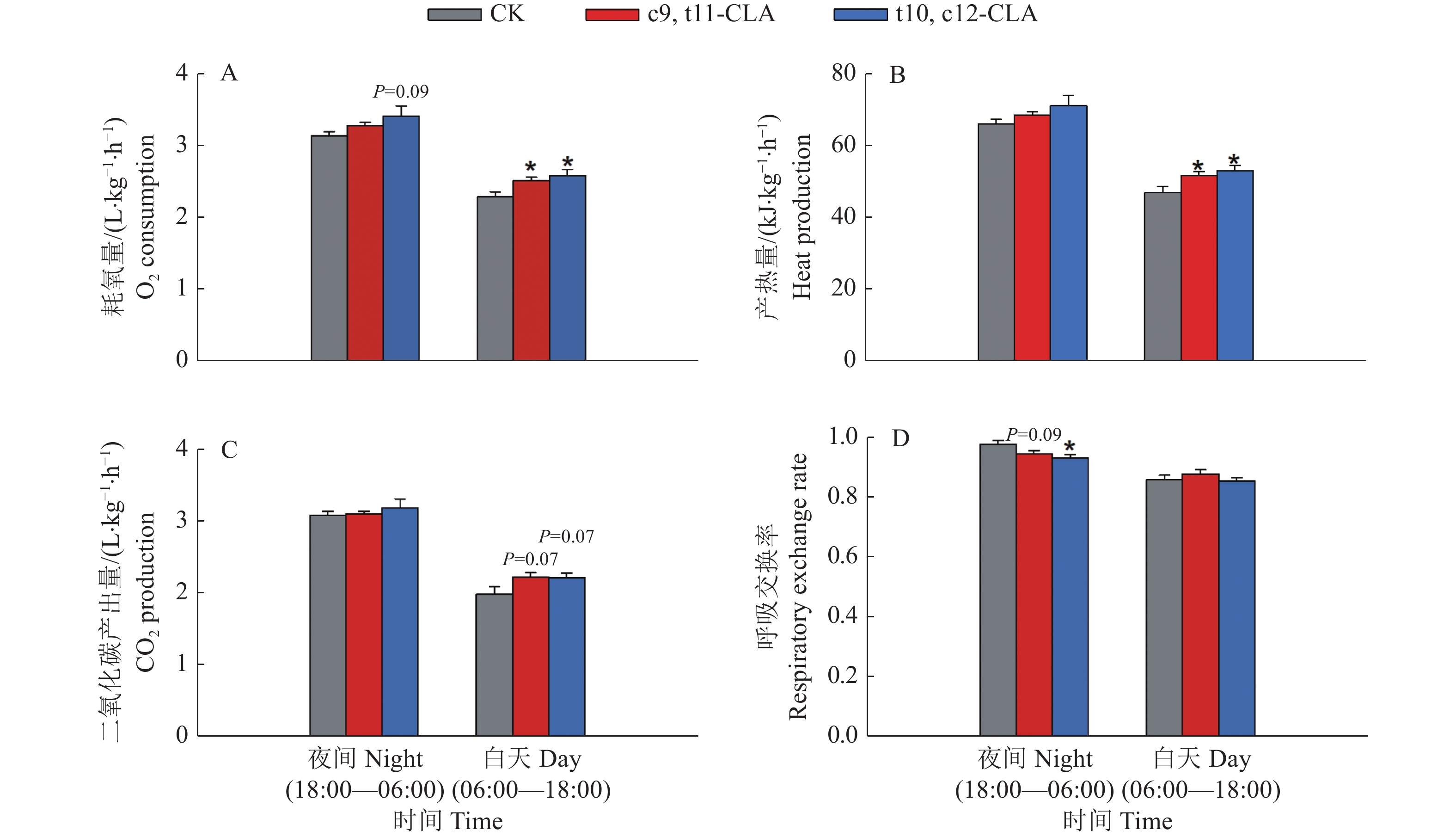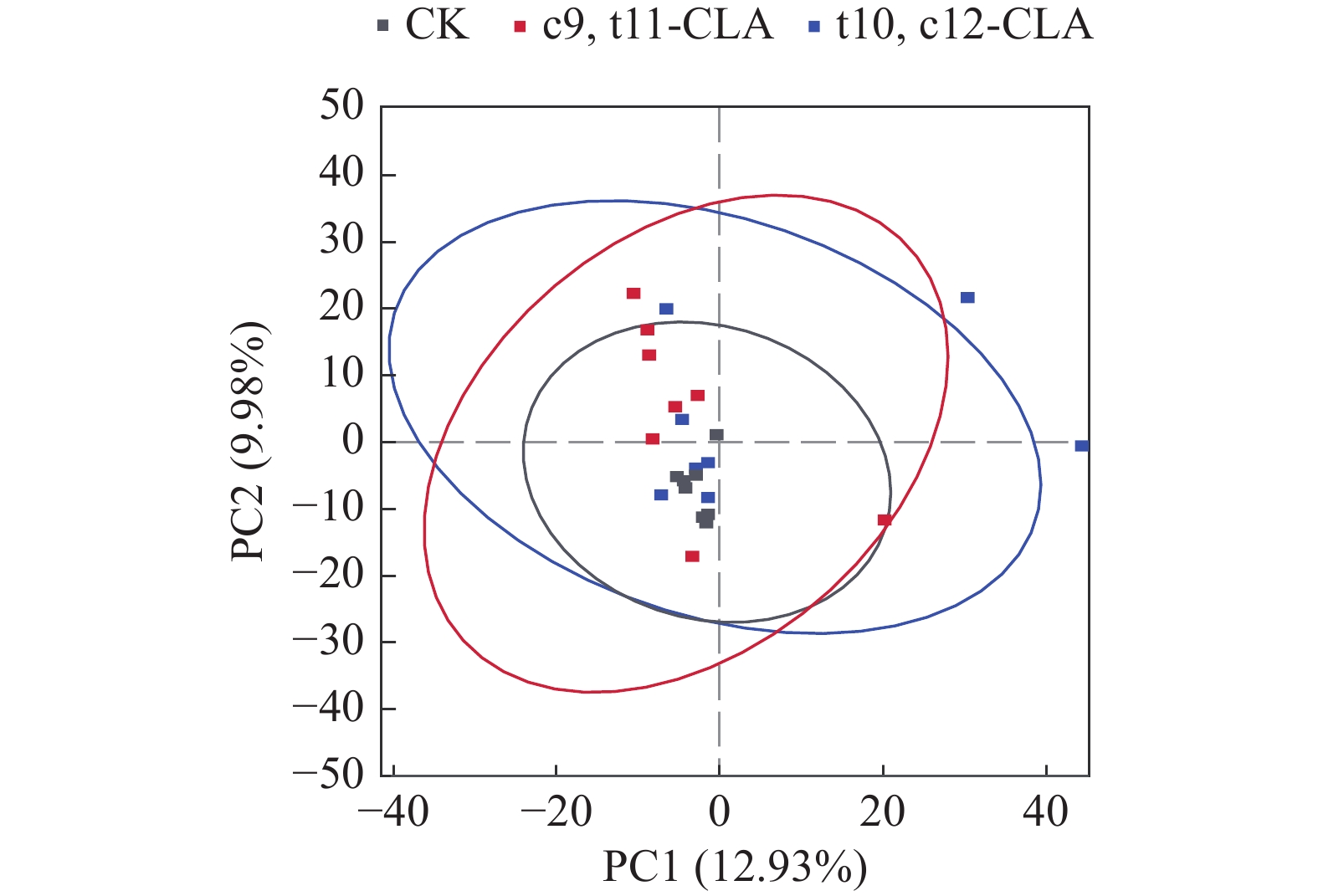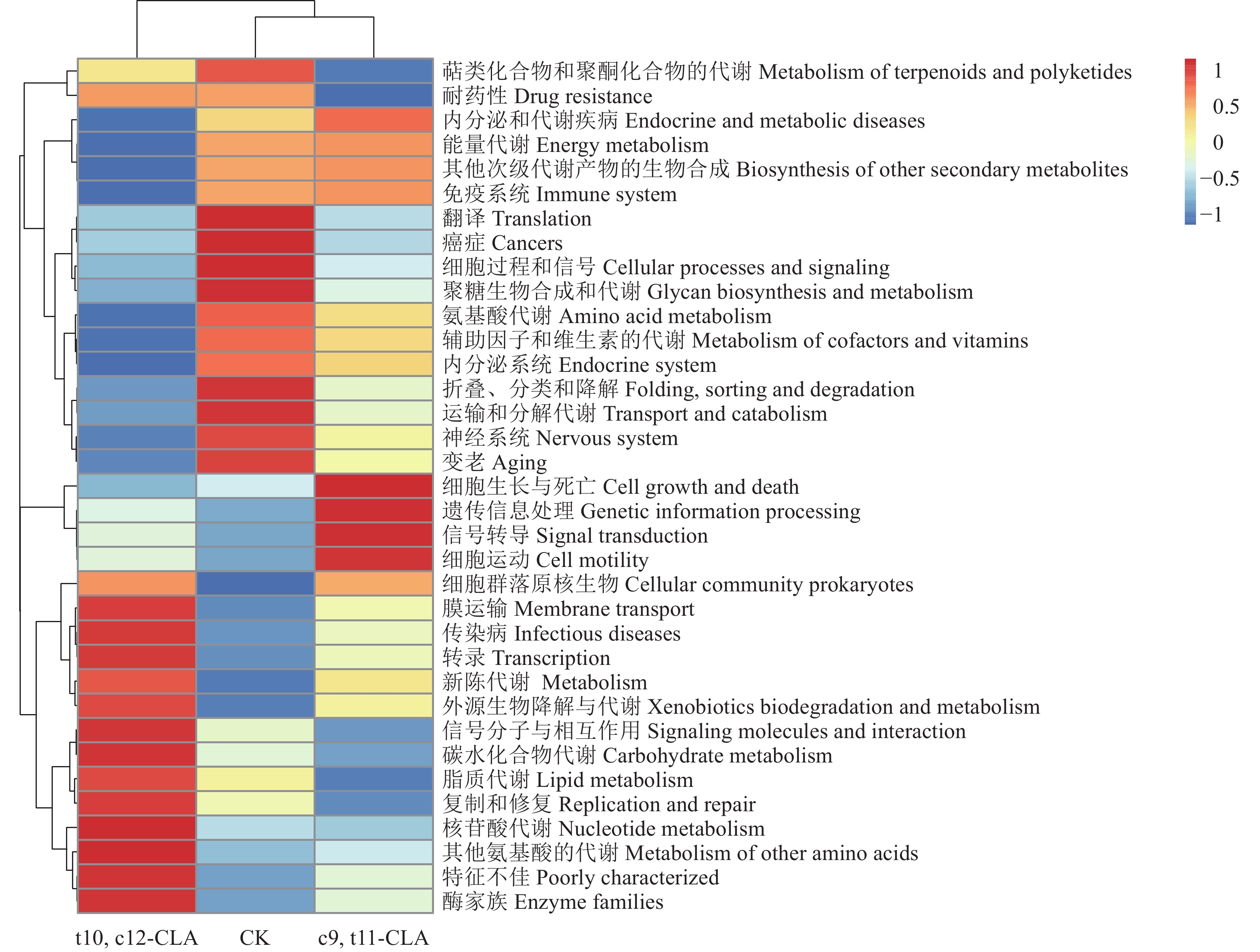Effects of different conjugated linoleic acid isomers on fat deposition, energy metabolism and gut microbiota in mice
-
摘要:目的
探究日粮添加不同共轭亚油酸(Conjugated linoleic acid,CLA)异构体对小鼠体脂、能量代谢和肠道微生物的影响。
方法用普通日粮(对照组)、普通日粮分别添加质量分数为2%的顺9,反11−共轭亚油酸(c9, t11-CLA)和反10,顺12−共轭亚油酸(t10, c12-CLA)饲喂小鼠12周,检测小鼠脂肪含量、能量代谢和肠道微生物的变化。
结果与对照组相比,c9, t11-CLA和t10, c12-CLA组小鼠体质量分别降低了22.79%和25.04%;脂肪含量分别降低了57.98%和59.41%;小鼠皮下脂肪、附睾白色脂肪以及褐色脂肪含量也显著降低。c9, t11-CLA和t10, c12-CLA均显著提高小鼠耗氧量和产热量,其中,t10, c12-CLA显著降低小鼠夜间的呼吸交换率。16S rRNA测序结果显示,3组小鼠的肠道微生物菌群结构存在明显差异,c9, t11-CLA和t10, c12-CLA组小鼠肠道中与机体代谢相关的菌群丰度显著高于对照组,且t10, c12-CLA能促进与脂质代谢相关的菌群丰度上调。在门水平,c9, t11-CLA和t10, c12-CLA组厚壁菌门和放线菌门相对丰度显著上调,拟杆菌门和疣微菌门相对丰度显著下调;在属水平,与对照组相比,c9, t11-CLA组双歧杆菌属相对丰度显著上调,Ileibacterium和Akkermansia相对丰度显著下调。
结论日粮添加c9, t11-CLA或t10, c12-CLA,可显著降低小鼠脂肪沉积,这可能与CLA促进机体能量代谢和改变肠道微生物菌群结构有关。
Abstract:ObjectiveThe purpose of this study was to investigate the effects of dietary supplementation of different conjugated linoleic acid (CLA) isomers on body fat, energy metabolism and gut microbiota in mice.
MethodMice were fed with normal diet (control group), normal diet supplemented with 2% cis-9, trans-11 conjugated linoleic acid (c9, t11-CLA) and trans-10, cis-12 conjugated linoleic acid (t10, c12-CLA) for 12 weeks respectively. The changes of fat content, energy metabolism and gut microbiota were detected.
ResultCompared with the control group, the body weight of mice in the c9, t11-CLA and t10, c12-CLA groups decreased by 22.79% and 25.04% respectively, the fat contents decreased by 57.98% and 59.41% respectively, and the contents of subcutaneous fat, epididymal white fat and brown fat also decreased significantly. In addition, c9, t11-CLA and t10, c12-CLA significantly increased oxygen consumption and heat production in mice, and t10, c12-CLA significantly decreased the nocturnal respiratory exchange rate. The 16S rRNA sequencing results showed that there were obvious differences in gut microbial community structure among three groups of mice. The abundances of metabolism-related flora in the guts of mice in c9, t11-CLA and t10, c12-CLA groups were significantly higher than that in the control group, and t10, c12-CLA could promote the up-regulation of lipid metabolism-related flora. At the phylum level, compared with the control group, the relative abundances of Firmicutes and Actinobacteria in c9, t11-CLA and t10, c12-CLA groups were significantly up-regulated, while the relative abundances of Bacteroidetes and Verrucomicrobia were significantly down-regulated. At the genus level, compared with the control group, the relative abundance of Bifidobacterium in c9, t11-CLA group was significantly up-regulated, while the relative abundances of Ileibacterium and Akkermansia were significantly down-regulated.
ConclusionDietary supplementation with c9, t11-CLA or t10, c12-CLA can significantly reduce fat deposition in mice, which may be related to the elevated energy metabolism and altered gut microbial community structure induced by CLA.
-
Keywords:
- Mouse /
- Diet /
- Conjugated linoleic acid /
- Fat deposition /
- Energy metabolism /
- Gut microbiota
-
荔枝Litchi chinensis Sonn. 属于无患子科Sapindaceae荔枝属果树,由于其果实色泽艳丽、滋味甜美、营养丰富,有着“百果之王”的美誉[1]。然而,荔枝栽培面临着众多挑战,有近30种病原真菌可侵染为害荔枝,其中,由刺盘孢属真菌Colletotrichum spp. 引起的炭疽病对荔枝果树生长及果实采后贮藏影响较大[2]。炭疽病主要发生在荔枝叶片、花穗、枝梢和果实,造成植物组织的干枯、坏死,引起落花、落果,发病率最高可达90%[2];采后易造成果实变褐腐烂,显著缩短贮藏和运输时间,严重影响果实食用品质和经济价值,果实贮藏2~3 d后开始发病,发病率在28%~60%,给果农造成巨大的经济损失[3]。本文从荔枝炭疽病的症状、病原菌种类、生物学特性、发生规律、致病机理以及病害防治等方面进行综述,为今后该病害的发病机理和抗病品种选育研究以及综合防治提供参考。
1. 荔枝炭疽病的症状和病原菌
1.1 荔枝炭疽病的症状
荔枝炭疽病可为害嫩梢、叶片、花穗、枝条和果实,以临近成熟或成熟的果实受害最为严重,造成梢枯、枝枯、落叶、落花和果实成熟期大量落果,也是造成果实贮运期间腐烂的重要病害。叶片感病后,在叶片上形成圆形或不规则褐色病斑,或在叶尖、叶缘产生黄褐色病斑并向基部和中脉扩展,发病部位与健康部位界线分明,后期融合成灰色的大病斑并着生许多黑色小粒(即病菌的分生孢子盘)。花穗感病时在花梗和穗梗上产生褐色病斑,然后干枯,造成大量落花。枝梢感病时在枝条上形成暗褐色病斑,造成枝梢回枯,夏梢发病最重、春梢次之、秋梢相对较轻。荔枝果实感病后症状较为复杂,幼果或青果则在果皮上出现褐色小斑,逐渐扩展为圆形或近圆形褐斑,引起早期落果;成熟或将近成熟的果实极易感病,病斑常发生于果实端部,多呈圆形、褐色、边缘棕褐色,湿度大时,病斑中央常产生橙红色黏质小粒,即病原菌的分生孢子团,造成裂果和烂果,严重时整个果实腐烂变质[1-2,4](图1A、1B、1E)。
但有的品种,如桂味荔枝,先在果蒂、果肩部位形成褐色至黑色芝麻点状小斑点,斑点直径约1 mm 或更小,随着病情的发展,斑点逐渐增多,聚集成大块黑斑,严重时几乎遍布整个果面,但不引起果皮和果肉腐烂,故将该症状类型称之为荔枝麻点病,果农俗称其为“鸭头绿” “黑点病”或“青鸡头”。此症状为荔枝炭疽病的一个特别类型,由暹罗刺盘孢C. siamense引起,多为害果实,叶片上也时有发生[5](图1C、1D)。
1.2 荔枝炭疽病病原种类
由刺盘孢属真菌引起的植物病害统称炭疽病,该属真菌也是世界十大植物病原真菌之一[6]。传统以寄主和形态为依据的刺盘孢属真菌分类[7-8]不能反映物种间的系统发育关系,并且在很大程度上阻碍了对该属物种多样性的研究[9]。基于多基因系统发育学,结合形态学、地理学和生态学建立的自然分类系统能够科学地反映该属物种间的系统发育关系,得到诸多学者的采纳并鉴定出大量的刺盘孢属新种 [9-12]。目前共报道了16个刺盘孢属复合种Colletotrichum species complex [11]。
为了解荔枝炭疽病菌的生物多样性并更好地监测和控制该病害,本文对荔枝炭疽病菌的种类进行了系统梳理。从时间角度来看,荔枝炭疽病菌种类的变迁及确定经过了近半个世纪。2000年以前,研究者主要依据Sutton[7-8]提出的分类系统进行鉴定,将荔枝炭疽病病原鉴定为盘长孢状刺盘孢复合种C. gloeosporioides species complex。2009年之后,随着多基因系统发育学的自然分类系统的广泛应用,大量的荔枝炭疽病菌新种或新记录种被鉴定和报道(图2)。2012年,Weir等[13]发现荔枝炭疽病菌新记录种热带刺盘孢C. tropicale;2015年,何宁等[14]将我国荔枝炭疽病病原菌鉴定为番石榴刺盘孢C. guajavae、睡莲刺盘孢C. nymphaeae、果生刺盘孢C. fructicola和暹罗刺盘孢;2016年,Shivas等[15]发现澳大利亚的荔枝炭疽病病原菌主要为盘长孢状刺盘孢C. gloeosporioides、暹罗刺盘孢、尖孢刺盘孢C. acutatum、昆士兰莎草刺盘孢C. queenslandicum、西蒙氏刺盘孢C. simmondsii和猴欢喜刺盘孢C. sloanei;2019年,凌金锋等[16-18]将采集自广东、广西、海南和四川4个省(区)的15个荔枝品种的炭疽病菌鉴定为松针刺盘孢C. fioriniae、果生刺盘孢、喀斯特刺盘孢C. karsti、普氏刺盘孢C. plurivorum 和暹罗刺盘孢,并将我国大陆荔枝炭疽病中一个特有症状——麻点病的病原鉴定为暹罗刺盘孢[18]。2021年,李少卡等[19]对海南荔枝炭疽病菌种类的构成进行分析发现,海南荔枝炭疽病的病原菌为盘长孢状刺盘孢、果生刺盘孢、暹罗刺盘孢、亚洲刺盘孢C. asianum、香蕉刺盘孢C. musae、卡哈瓦刺盘孢卡哈瓦亚种C. kahawae subsp. kahawae和哈锐刺盘孢C. horri。2023年,Huang等[20]发现果生刺盘孢、暹罗刺盘孢和长直孢刺盘孢C. gigasporum是引起广西荔枝炭疽病的主要病原;Cao等[21]发现海南荔枝炭疽病原主要为喀斯特刺盘孢、儋州刺盘孢C. danzhouense、长直孢刺盘孢、槟榔刺盘孢C. arecicola、果生刺盘孢、暹罗刺盘孢、芭蕉生刺盘孢C. musicola 和普氏刺盘孢。2024年,Anderson等[22]将澳大利亚的荔枝炭疽病菌鉴定为外来刺盘孢C. alienum、果生刺盘孢、昆士兰莎草刺盘孢和暹罗刺盘孢。
![]() 图 2 荔枝炭疽病菌发现时间轴线图中不同背景颜色的荔枝炭疽病菌表示归属于不同的刺盘孢复合种;括号里面的内容表示报道的作者及其报道年份;CN、AU和JA分别表示该病菌的地理分布为中国、澳大利亚和日本。Figure 2. Timeline for discovering litchi anthracnose pathogenic speciesPathogens of litchi anthracnose with different background colors represented different Colletotrichum species complex; The details in parentheses indicated the reporter and the reported year of the pathogens; CN, AU and JA indicated the distribution of the pathogens in China, Australia and Japan respectively .
图 2 荔枝炭疽病菌发现时间轴线图中不同背景颜色的荔枝炭疽病菌表示归属于不同的刺盘孢复合种;括号里面的内容表示报道的作者及其报道年份;CN、AU和JA分别表示该病菌的地理分布为中国、澳大利亚和日本。Figure 2. Timeline for discovering litchi anthracnose pathogenic speciesPathogens of litchi anthracnose with different background colors represented different Colletotrichum species complex; The details in parentheses indicated the reporter and the reported year of the pathogens; CN, AU and JA indicated the distribution of the pathogens in China, Australia and Japan respectively .目前共报道22种刺盘孢属真菌可以引起荔枝炭疽病,分别属于5个复合种:1)盘长孢状刺盘孢复合种,包括盘长孢状刺盘孢[3-4]、果生刺盘孢[14]、暹罗刺盘孢[14,16]、热带刺盘孢[13]、香蕉刺盘孢[19]、亚洲刺盘孢[19]、卡哈瓦刺盘孢卡哈瓦亚种[19]、哈锐刺盘孢[19]、槟榔刺盘孢[21]和外来刺盘孢[22];2)尖孢刺盘孢复合种C. acutatum species complex,包括尖孢刺盘孢[12]、松针刺盘孢[12,17]、番石榴刺盘孢[14]、睡莲刺盘孢[14]、昆士兰莎草刺盘孢[15]、西蒙氏刺盘孢[12]和猴欢喜刺盘孢[15];3)博宁刺盘孢复合种C. boninense species complex,包括喀斯特刺盘孢[16];4)兰科刺盘孢复合种C. orchidearum species complex,包括芭蕉生刺盘孢[21]和普氏刺盘孢[16];5)长直孢刺盘孢复合种C. gigasporum species complex,包括儋州刺盘孢[21]和长直孢刺盘孢[20]。荔枝炭疽病病原多样性的研究主要集中在我国,研究表明引起荔枝炭疽病的病原种类存在地域和品种之间的差异;受地理环境和品种的影响,荔枝炭疽病原菌优势种也有所差异;盘长孢状刺盘孢是我国的优势复合种,其优势种为果生刺盘孢和暹罗刺盘孢。
1.3 荔枝炭疽病菌的生物学特性
荔枝炭疽病菌的生物学特性研究大多以盘长孢状刺盘孢(复合种)为研究对象。该菌菌丝在8~38 ℃均能生长,最适生长温度为28 ℃。在PDA平板上28 ℃培养,第7天菌丝布满全皿(9 cm);菌丝初期为白色绒状,随菌龄的增长逐渐由白色转为灰白色,最后变成黑褐色。产孢的温度范围为12~36 ℃,最适产孢温度为28~32 ℃,24 ℃以下或32 ℃以上产孢量明显下降[23]。张新春等[24]研究发现,分生孢子在相对湿度低于85%时不能萌发,湿度越高越有利于孢子的萌发;孢子萌发不需要外界营养,但糖类(葡萄糖、蔗糖、麦芽糖和果糖等)可促进分生孢子的萌发。菌丝对高温的耐受能力比分生孢子强,50 ℃ 水处理10 min可以使分生孢子致死,而菌丝必须在60 ℃水处理30 min才被杀死。盘长孢状刺盘孢对酸碱度的适应能力强,pH为3~10均能生长和产孢。菌丝在偏酸性条件生长较快,最适pH为5~6;强酸性条件下菌丝生长受抑制,但适合分生孢子的产生,产生分生孢子最适pH为3~4,分生孢子萌发最适pH为6~7[23]。光照条件对盘长孢状刺盘孢的生长发育无显著影响,在有、无光照的条件下均可正常生长和产孢[23-24]。
1.4 炭疽病菌的致病机理
荔枝炭疽病菌致病机制的研究极少,仅见Chudasama等[25]报道果胶裂解酶基因pnl-1为荔枝炭疽病菌的致病因子。引起植物炭疽病的刺盘孢属真菌虽然种类多样但是侵染过程具有共同的特点,即:病原菌的分生孢子萌发形成芽管,产生附着胞;附着胞成熟黑化后产生巨大的膨压,然后产生侵染钉,侵染钉侵染植物细胞后产生侵染囊泡;侵染囊泡继而形成初生菌丝,初生菌丝粗大且多分支,此时植物仍然处于活体阶段,当第一个细胞死亡后,初生菌丝迅速发展为细长的次生菌丝,随之侵染其他相邻的细胞[26]。刺盘孢属真菌侵染植物的过程中,穿透植物细胞壁主要依赖于角质层酶和附着胞膨压,附着胞黑化是附着胞维持穿透所需巨大膨压的必要因素。该属真菌对寄主植物的侵染过程和致病机理见表1。
表 1 已报道的引起炭疽病的致病因子Table 1. The reported pathogenic factors of Colletotrichum侵染过程
Infection process致病因子
Pathogenic factor基因
Gene种类
Species参考文献
Reference穿透寄主表面前
Pre-penetration of
host surface附着胞细胞壁蛋白 Cap20 盘长孢状刺盘孢 C. gloeosporioides [27] 附着胞细胞壁蛋白 Cap22 盘长孢状刺盘孢 [28] 金属硫蛋白 Cap3 盘长孢状刺盘孢 [28] 金属硫蛋白 Cap5 盘长孢状刺盘孢 [28] 异柠檬酸裂合酶 ICL1 瓜类刺盘孢 C. lagenarium [29] 蛋白激酶 RPK1 瓜类刺盘孢 [30] 甾醇糖基转移酶 Chip6 盘长孢状刺盘孢 [31] 穿透寄主表面
Penetration of host
surface角质酶 CutA 盘长孢状刺盘孢 [32] 聚酮合成酶 Pks1 瓜类刺盘孢 [33] 铜离子转运ATP酶 Clap1 豆类刺盘孢 C. lindemuthianum [34] 小柱孢酮脱水酶 Scd1 瓜类刺盘孢 [35] 单羧酸转运蛋白 CgMCT1 盘长孢状刺盘孢 [36] 寡肽转运因子 CgOPT2 盘长孢状刺盘孢 [36] 1,3,8−二羟基萘还原酶 Thr1 瓜类刺盘孢 [37] 泛素结合酶蛋白 Chip1 盘长孢状刺盘孢 [38] 漆酶 Lac2 圆孢刺盘孢 C. orbiculare [39] 假定钙调素激酶 CaMK 盘长孢状刺盘孢 [40] 四跨膜区蛋白 Pls1 豆类刺盘孢 [41] 自噬相关蛋白 Atg26 瓜类刺盘孢 [42] 穿透寄主表面相关的
信号转导途径
Signal transduction of
penetrating host
surface假定的丝氨酸/苏氨酸激酶 Clk1 豆类刺盘孢 [43] 过氧化物酶体蛋白 ClaPEX6 瓜类刺盘孢 [44] 丝裂原活化蛋白激酶 Cmk1 瓜类刺盘孢 [45] MAPK激酶 CgMEK 盘长孢状刺盘孢 [46] cAMP依赖性蛋白激酶 CtPKAC 苜蓿刺盘孢 C. trifolli [47] cAMP依赖性蛋白激酶 CgPKAC 盘长孢状刺盘孢 [48] 穿透寄主表面相关
的转录因子
Transcriptional
factors of penetrating host
surface转运因子 CLTA1 豆类刺盘孢 [49] Ste12 CST1 瓜类刺盘孢 [50] Ste12-like CLSTE12 豆类刺盘孢 [51] 转录因子 CMR1 葫芦刺盘孢 C. lagenaria [52] 肌动相关蛋白 ArpA 盘长孢状刺盘孢 [53] pH响应转录因子 PacC 尖孢刺盘孢 C. acutatum [54] 穿透寄主表面相关
的水解酶
Hydrolytic enzymes of
penetrating host
surface果胶酸裂解酶 CgPel 盘长孢状刺盘孢 [55] 果胶酸裂解酶 CgPel 盘长孢状刺盘孢 [56] 果胶酸裂解酶 Pel 壮丽刺盘孢 C. magna [57] 果胶酸裂解酶 PelB 盘长孢状刺盘孢 [58] 果胶酸裂解酶 PecCl1 豆类刺盘孢 [59] 果胶酸裂解酶 CcpelA 球刺盘孢 C. coccodes [60] 果胶酸酯裂解酶 PnlA 盘长孢状刺盘孢 [61] 在盘长孢状刺盘孢致病机制研究方面,Li等[53]发现了一个肌动蛋白相关基因ArpA,该基因参与产孢过程,导致分生孢子不能正常形成,且无法形成附着胞,进而影响了后续致病过程;Wu等[36]通过农杆菌介导的遗传转化方法,获得了与产孢和菌丝白化相关的基因,分别为单羧酸转运蛋白基因CgMCT1和寡肽转运因子CgOPT2;Liu等[38]发现一个泛素结合酶蛋白基因Chip1可调控分生孢子的萌发;Hwang等[28]报道了与附着胞侵入有关的CAP20基因;Kim等[40]发现参与调控分生孢子的萌发和附着胞形成的假定钙调素激酶基因CaMK和甾醇的糖基转移酶基因Chip6[31]。此外, PelB、Pel和PnlA等基因调控病原菌产生果胶酶来降解植物细胞的细胞壁,使其能更加顺利进入细胞植物并在细胞内定殖[56,58,61]。
豆类刺盘孢C. lindemuthianum的四跨膜区蛋白基因ClPLS1调控了侵入钉的发育[41],类Ste12转录调节因子CST1参与调控附着胞的侵入[50],铜离子转运ATP酶基因Clap1调控附着胞内黑色素的合成[34]。希金斯刺盘孢的cAMP-PKA信号通路参与调控菌株生长与致病相关过程[62]。Wei等[63]对一个编码MAPK的基因ChMK1进行了敲除,并验证了该基因敲除转化子的细胞壁完整性、附着胞的形成以及致病力的差异,发现该基因与希金斯刺盘孢细胞壁完整性、黑色素形成以及致病相关。
瓜类刺盘孢C. lagenarium中,报道了参与调控附着胞侵入的异柠檬酸裂合酶基因ICL1[29];参与调控附着胞侵入及生长的蛋白激酶A基因RPK1[30];调控附着胞的功能以及黑化的过氧化物酶体蛋白ClaPEX6[44];参与调控附着胞黑色素合成的聚酮合成酶基因PKS1[33]、小柱孢酮脱水酶基因SCD1[35]、1,3,8−二羟基萘还原酶基因THR1[37]和转录因子基因CMR1[52]。
苜蓿刺盘孢C. trifolii中,Yang等[47]发现有一个依赖于cAMP的蛋白激酶基因CtPKAC,可以调控分生孢子的产生,经过基因敲除后,转化子产生的分生孢子不能正常侵染寄主植物。以上研究结果为揭示荔枝炭疽病菌致病机制提供了很好的研究基础。然而,不同寄主间同一病原菌的致病机制不尽相同,探索荔枝炭疽病菌致病机制将是今后深入研究的重点。
2. 荔枝炭疽病的发生规律和防治技术
2.1 荔枝炭疽病的发生规律
了解病害的发生规律对指导病害防治具有重要意义。荔枝炭疽病菌以菌丝或分生孢子在树上的病叶或以分生孢子盘随病叶或病果落于地面越冬,成为下一季发病的初侵染源。越冬后的分生孢子通过风、雨或昆虫传播,条件适宜时萌发,从寄主表面直接或自伤口侵入;植株发病后将产生大量新的分生孢子,经传播可频繁地进行再侵染[64-65]。炭疽病在高温、多雨、高湿的季节发生严重,危害的严重程度与雨量的大小呈正相关性[66]。
广东荔枝叶片发生炭疽病始于4月中旬,从4月下旬至5月上旬为第1次发病高峰期;5月下旬至6月中旬为第2次发病高峰期;9月上旬以后病害发生较轻,但如果9月遇阴雨天气则可能发生第3次高峰期。果实于4月下旬开始感病,雨水越多发病越重,一般早熟品种发病较少,晚熟品种发病较多。12月气候渐凉,病害停止增长[67-68]。通过对云南5个荔枝主产区荔枝炭疽病的调查统计发现,每年4—9月是荔枝炭疽病集中发生时期,且在6—8月为害程度较高[69]。广西的荔枝炭疽病在4月下旬至5月、5月下旬至6月各有一个病害发生高峰期,与荔枝春、夏抽梢时间吻合;不同的荔枝品种在田间的发病情况不同,‘灵山香荔’‘三月红’‘禾荔’等发病较轻,‘妃子笑’‘白糖罂’等发病较重[70]。海南荔枝果实成熟期的4—5月是荔枝炭疽病发生最为严重时期[4]。
2.2 荔枝炭疽病的防治技术
荔枝炭疽病对我国荔枝产业构成了严峻挑战,田间的防控策略采取了多元化的方法,核心在于农业防治措施,比如定期修剪病弱枝条、密闭园间伐改造[71],以改善通风透光条件,及时清除病叶病果以减少侵染源,通过合理除草和科学施肥维护树体健康。化学防治作为辅助手段,在荔枝开花前、幼果期和果实采摘前期可以有效控制病情扩散。此外,生物防治也是该病害防控不可或缺的重要方法,如利用有益微生物制剂,通过营养竞争或直接抑制病原菌生长,既减少了化学农药的依赖,又保护了生态环境。华南农业大学姜子德团队提出了以农业措施和生态调控为基础、病害早期精准诊断与预警为前提、高效低风险农药为载体、抗药性和果实追踪管理制度为保障的一套荔枝炭疽病绿色防控技术,这种综合防控技术不仅有效控制了病害,还促进了荔枝产业的可持续发展[72]。
2.2.1 化学防治
化学药剂防治方法见效快、操作简单且效率高,科学使用可在病害产生流行之前控制病害大面积的传播,在农业生产中发挥着至关重要的作用。目前,通过室内药剂筛选和田间试验,用于防治荔枝炭疽病的化学药剂主要有咪鲜胺、腈菌唑、苯醚甲环唑、嘧菌酯、吡唑醚菌酯、多·锰锌、咪锰·多菌灵、唑醚·代森联、氯氟醚·吡唑酯、氟菌·肟菌酯和苯甲·嘧菌酯等 [73-75]。然而,由于各荔枝果园管理水平不一,长期单一使用或过量使用化学药剂的现象较为普遍,极易导致病原菌产生抗药性,降低防效。研发不同作用机理的杀菌剂复配制剂成了抗药性治理的一个重要措施[76]。针对荔枝炭疽病菌的抗药性监测也取得了一些进展。董丁铭[77]的研究表明,在荔枝炭疽病菌菌株中,对甲基硫菌灵产生抗性的菌株数占比为42.45%,对咪鲜胺产生抗性的菌株数占比为0.28%,对嘧菌酯产生抗性的菌株数占比为6.32%;交互抗药性研究结果表明,甲基硫菌灵与噻菌灵、多菌灵有正交互抗性,与乙霉威有负交互抗性,咪鲜胺与苯醚甲环唑、吡唑醚菌酯、咯菌腈、噻菌灵、百菌清、甲基硫菌灵、戊唑醇没有交互抗性,嘧菌酯与吡唑醚菌酯有正交互抗性,而与其他杀菌剂没有交互抗性。该结果为荔枝生产上使用杀菌剂提供了有力的科学依据。
在荔枝采后贮运期炭疽病的防治方面,相关学者对药剂处理方法和药剂筛选做了一些探索。谷会等[78]研究表明,采前药剂处理对采后炭疽病有较好的防治效果;温书恒等[79]针对包括荔枝炭疽病菌在内的主要采后病原微生物进行了药剂筛选,发现咪鲜胺和抑霉唑的抑菌效果明显;周灵灵等[80]研究了食品防腐剂R−多糖对荔枝炭疽病菌的抑制机理,发现R−多糖对病菌菌丝生长和孢子萌发有较好的抑菌活性,R−多糖处理后的病菌菌丝细胞膜通透性增加,细胞内容物大量流失,菌丝严重畸变和凋亡。
2.2.2 微生物源杀菌剂
在荔枝炭疽病的生物防治方面,枯草芽孢杆菌Bacillus subtilis OR−1、OR−2、OR−3、ON−6、CF−3和解淀粉芽孢杆菌B. amyloliquefaciens LY−1都显示出抗荔枝盘长孢状刺盘孢的活性[81-88]。CF−3的挥发性物质结合热处理可显著降低荔枝果实腐烂指数,有效保持果实硬度和可溶性固形物含量,降低果实失重率[85,87]。LY−1的培养液可延缓荔枝果皮褐变进程,降低果实腐烂程度和失重率,并在贮藏过程中保持较高的品质,是一种很有前景的延长荔枝果实货架期的生物防治方法[88]。荧光假单胞菌Pseudomonas fluorescens M18分泌的申嗪霉素对荔枝盘长孢状刺盘孢的抑制效果明显,在田间及采后室内贮藏条件下均可以很好地防控荔枝炭疽病的发生[89]。Cui等[90]从甘蔗叶片中分离得到1株内生唐菖蒲伯克霍尔德氏菌 Burkholderia gladioli,且对荔枝暹罗刺盘孢的菌丝生长有较强的抑制作用。
除了细菌在防治炭疽病中发挥着重要作用,生防真菌的应用也为荔枝炭疽病的防治提供了便利。海洋真菌布雷正青霉Eupenicillium brefeldianum、微紫青霉Penicillium janthinellum和草酸青霉P. oxalicum对荔枝盘长孢状刺盘孢有较强的抑制作用[91]。热带假丝酵母Candida tropicalis YZ1和YZ27以及酿酒酵母Saccharomyces cerevisiae YZ7显著减少了刺盘孢对荔枝果实的潜在侵染[92]。蔚慧等[93]用透射电镜观察法分析了荔枝炭疽病菌菌丝与绿色木霉代谢物反应后的变化,发现被绿色木霉代谢产物拮抗后的荔枝炭疽病菌菌丝细胞核产生形变,细胞质变成了胶体状态,内部的液泡膨胀变形,线粒体和叶绿体分化成细小的颗粒,说明绿色木霉代谢物是一种重要的抑菌剂。
2.2.3 植物源杀菌剂
药用植物的抑菌成分已广泛用于医药行业,这也为开发天然、安全和高效的植物源杀菌剂提供了丰富的理论基础。陈兴龙等[94]测定了31种植物组织的甲醇提取物对荔枝炭疽病菌的抑菌活性,结果表明菊科草本植物一点红Emilia sonchifolia提取物的抑菌率达到100%,罂粟科植物地丁草Corydalis bungeana提取物的抑菌率为 71.35%,利用这些具有较好抑菌活性的植物材料防控荔枝炭疽病具有广阔的前景。胡珊等[95]研究了4种植物精油的抑菌效果,结果表明对荔枝炭疽病菌的抑制能力从大到小依次为:香芹酚>丁香酚>肉桂醛>柠檬醛,且随着精油浓度的增加,抑菌能力增强。桉叶精油(Eucalyptus essential oils, EEO)来源天然、成本低廉、安全,具有广谱抑菌性,在果蔬保鲜中具有良好的应用前景。采用包合法制备的桉叶精油微胶囊可延缓荔枝果实感官品质的下降,减缓维生素C(Vitamin C, VC)的氧化以及可滴定酸(Titratable acidity, TA)、可溶性固形物(Total soluble solides, TSS)等的消耗,较好地保持了果实的营养品质,还可作为抑菌保鲜剂用于制备抑菌保鲜膜[96]。
2.2.4 物理防治
物理防治是现代植物保护技术的重要组成部分,是利用光、热、电、温和辐射等各种物理因素和机械设备进行病害防治的技术方法。最近的研究发现,发光二极管(Light-emitting diode, LED)技术被用来研究防控荔枝采后病害,紫光(410~420 nm)对白地霉Geotrichum candidum和镰刀菌Fusarium sp.引起的荔枝采后病害的抑制效果明显,是一种很有前途的物理防治方法[97],给控制荔枝炭疽病引起的果实腐烂提供了一种新思路。
2.2.5 纳米材料
化学药剂带来的副作用无可避免,新兴纳米材料因作用靶向性强、持效性强和环境污染风险低等优点越来越受到人们的关注,如利用氧化锌纳米颗粒可以有效地防控黑曲霉Aspergillus niger引起的荔枝采后腐烂[98]。Bui等[99] 利用姜黄素生产过程中的副产物姜黄油树脂(Curcumin-removed turmeric oleoresin,CRTO)制备植物源杀菌剂的纳米乳剂,CRTO纳米乳剂对荔枝盘长孢状刺盘孢菌丝生长有明显抑制作用,田间试验显示能有效地控制荔枝炭疽病的发生。
2.2.6 抗病育种
防治荔枝炭疽病最经济有效的方法就是培育抗病品种,但鲜见抗炭疽病荔枝品种的相关研究报道。最近,李芳等[100]对荔枝资源进行室内抗性评价,建立了利用荔枝离体叶片评价抗炭疽病的技术方法,从而为筛选荔枝抗病种质、加快荔枝抗病育种进程提供了支撑。
3. 展望
荔枝炭疽病作为荔枝种植过程中普遍存在的严重病害,其发病与地理位置、气候环境及种植品种的差异密切相关。这些外部因素导致了病原菌在进化过程中呈现出显著的多样性,进而使得荔枝炭疽病的危害症状各不相同。近年来,针对荔枝炭疽病不同病原菌的分离与鉴定工作取得了显著进展,但关于其致病机制的理解仍然相对有限。今后应加强以下几方面的研究:
1)探究荔枝炭疽病的发病机理,为病害防控提供理论基础。未来的研究需要聚焦于病原菌的致病过程及其与荔枝寄主之间的复杂互作机制。通过高通量测序、基因编辑等先进技术,加快对荔枝炭疽病菌致病相关重要功能基因的鉴定,并利用蛋白互作技术精准筛选出与病原菌致病性密切相关的关键互作蛋白。这一系列的分子生物学研究将有助于鉴定出与荔枝抗性相关的基因,为病害的防控提供新的靶标,并为抗病育种奠定坚实的分子遗传学基础。
2)研发新型防治药剂,加强荔枝炭疽病菌抗药性治理。为了减缓病原菌对化学药剂的抗药性发展,我们需要不断研发新型药剂,通过添加助剂的方式提高药剂的防治效果,减少药剂的使用量,并推行交替使用具有不同作用机制的药剂或复配制剂的防治策略。此外,加强抗药性监测和科学用药指导,确保药剂使用的合理性和有效性,从而延缓荔枝炭疽病菌产生抗药性。
3)开发绿色防控技术,促进荔枝产业可持续发展。积极开发与推广生物防治技术及其他绿色防控技术,如利用拮抗菌、植物提取物等天然物质进行病害防控,不仅能够减少对化学药剂的依赖,降低生产成本,还能有效减少对环境的污染和对人体的潜在风险,促进荔枝产业的可持续发展。
-
图 2 2种共轭亚油酸异构体对小鼠脂肪沉积的影响
A为小鼠体内总脂肪和肌肉含量;B为小鼠体内不同脂肪或肌肉组织的质量与体质量的百分比,Ⅰ:腓肠肌,Ⅱ:胫骨前肌,Ⅲ:比目鱼肌,Ⅳ:趾长伸肌,Ⅴ:褐色脂肪,Ⅵ:附睾脂肪,Ⅶ:皮下脂肪,Ⅷ:肝脏;“***”表示与对照组差异达到0.001的显著水平 (t检验)
Figure 2. Effect of two conjugated linoleic acid isomers on fat deposition in mice
A is the total fat and muscle contents in mice; B is the percentages of different fat or muscle tissue weights in the body of mice to the body weight, I: Gastrocnemius muscle, II: Tibialis anterior muscle, III: Soleus muscle, IV: Extensor digitorum longus muscle, V: Brown fat, VI: Epididymal fat, VII: Subcutaneous fat, VIII: Liver; “***” indicates significant difference from control at 0.001 level (t test)
表 1 饲料组成和质量分数1)
Table 1 Feed composition and content
w/(g·kg−1) 组别
Group玉米淀粉
Corn starch酪蛋白
Casein麦芽糊精
Maltodextrin蔗糖
Sucrose豆油
Bean oilc9, t11-CLA CK 465.7 140.0 155.0 100.0 40.0 0 c9, t11-CLA 463.7 139.4 154.4 99.6 23.9 20 t10, c12-CLA 463.7 139.4 154.4 99.6 23.9 0 组别
Groupt10, c12-CLA 纤维素
Cellulose混合矿物质
Mixed minerals混合维生素
Mixed vitaminsL−胱氨酸
L-cystine酒石酸胆碱
Choline bitartrateCK 0 50.0 35.0 10 1.8 2.5 c9, t11-CLA 0 49.8 34.9 10 1.8 2.5 t10, c12-CLA 20 49.8 34.9 10 1.8 2.5 1) 豆油和共轭亚油酸的能值分别为37.638和29.972 kJ/g;各处理组总能值一样
1) The energy values of soybean oil and conjugated linoleic acid are 37.638 and 29.972 kJ/g respectively; Diffferernt treatment groups have the same total energy level表 2 2种共轭亚油酸异构体对小鼠生长的影响1)
Table 2 Effects of two conjugated linoleic acid isomers on growth of mice
组别
Group体质量/g
Body weight周平均采食量/g
Mean feed intake weeklyCK 27.64 ± 0.61 19.73 ± 0.37 c9, t11-CLA 21.34 ± 0.21*** 17.26 ± 0.63** t10, c12-CLA 20.72 ± 0.49*** 16.64 ± 0.34*** 1) “**”和“***”分别表示与对照组差异达到0.01和0.001的显著水平(t检验)
1) “**” and “***” indicate significant differences from control at 0.01 and 0.001 levels respectively (t test) -
[1] ARROYO-JOHNSON C, MINCEY K D. Obesity epidemiology worldwide[J]. Gastroenterology clinics of North America, 2016, 45(4): 571-579. doi: 10.1016/j.gtc.2016.07.012
[2] SILVESTRIS E, DE PERGOLA G, ROSANIA R, et al. Obesity as disruptor of the female fertility[J]. Reproductive Biology and Endocrinology:RB&E, 2018, 16(1): 22. doi: 10.1186/s12958-018-0336-z.
[3] NADERPOOR N, SHORAKAE S, JOHAM A, et al. Obesity and polycystic ovary syndrome[J]. Minerva Endocrinologica, 2015, 40(1): 37-51.
[4] BRAY G A, KIM K K, WILDING J P H, et al. Obesity: A chronic relapsing progressive disease process. A position statement of the World Obesity Federation[J]. Obesity Reviews: An Official Journal of the International Association for the Study of Obesity, 2017, 18(7): 715-723. doi: 10.1111/obr.12551
[5] KIM S W, WEAVER A C, SHEN Y B, et al. Improving efficiency of sow productivity: Nutrition and health[J]. Journal of Animal Science and Biotechnology, 2013, 4(1): 26. doi: 10.1186/2049-1891-4-26.
[6] PARIZA M W, PARK Y, COOK M E. The biologically active isomers of conjugated linoleic acid[J]. Progress in Lipid Research, 2001, 40(4): 283-298. doi: 10.1016/S0163-7827(01)00008-X
[7] KOBA K, AKAHOSHI A, YAMASAKI M, et al. Dietary conjugated linolenic acid in relation to CLA differently modifies body fat mass and serum and liver lipid levels in rats[J]. Lipids, 2002, 37(4): 343-350. doi: 10.1007/s11745-002-0901-7
[8] RYDER J W, PORTOCARRERO C P, SONG X M, et al. Isomer-specific antidiabetic properties of conjugated linoleic acid: Improved glucose tolerance, skeletal muscle insulin action, and UCP-2 gene expression[J]. Diabetes, 2001, 50(5): 1149-1157. doi: 10.2337/diabetes.50.5.1149
[9] LEHNEN T E, DA SILVA M R, CAMACHO A, et al. A review on effects of conjugated linoleic fatty acid (CLA) upon body composition and energetic metabolism[J]. Journal of the International Society of Sports Nutrition, 2015, 12: 36. doi: 10.1186/s12970-015-0097-4.
[10] 伏春燕, 张燕, 魏祥法, 等. 共轭亚油酸降低脂肪沉积的分子机制研究进展[J]. 动物营养学报, 2019, 31(8): 3456-3462. [11] BIRSOY K, FESTUCCIA W T, LAPLANTE M. A comparative perspective on lipid storage in animals[J]. Journal of Cell Science, 2013, 126(Pt 7): 1541-1552.
[12] SHREINER A B, KAO J Y, YOUNG V B. The gut microbiome in health and in disease[J]. Current Opinion in Gastroenterology, 2015, 31(1): 69-75. doi: 10.1097/MOG.0000000000000139
[13] CHO I, BLASER M J. The human microbiome: At the interface of health and disease[J]. Nature Reviews Genetics, 2012, 13(4): 260-270. doi: 10.1038/nrg3182
[14] WALDRAM A, HOLMES E, WANG Y, et al. Top-down systems biology modeling of host metabotype-microbiome associations in obese rodents[J]. Journal of Proteome Research, 2009, 8(5): 2361-2375. doi: 10.1021/pr8009885
[15] FEI N, ZHAO L. An opportunistic pathogen isolated from the gut of an obese human causes obesity in germfree mice[J]. The ISME Journal, 2013, 7(4): 880-884. doi: 10.1038/ismej.2012.153
[16] 刘丽娜, 缪锦来, 郑洲. 共轭亚油酸的生理功能综述[J]. 食品安全质量检测学报, 2020, 11(8): 2552-2557. [17] 夏珺, 郑明月, 李灵杰, 等. 共轭亚油酸改善肥胖糖尿病小鼠的糖脂代谢[J]. 南方医科大学学报, 2019, 39(6): 740-746. [18] LAROSA P C, RIETHOVEN J J, CHEN H, et al. Trans-10, cis-12 conjugated linoleic acid activates the integrated stress response pathway in adipocytes[J]. Physiological Genomics, 2007, 31(3): 544-553. doi: 10.1152/physiolgenomics.00156.2007
[19] VALEILLE K, FÉRÉZOU J, AMSLER G, et al. A cis-9, trans-11-conjugated linoleic acid-rich oil reduces the outcome of atherogenic process in hyperlipidemic hamster[J]. American Journal of Physiology Heart and Circulatory Physiology, 2005, 289(2): H652-H659. doi: 10.1152/ajpheart.00130.2005
[20] TSUBOYAMA-KASAOKA N, TAKAHASHI M, TANEMURA K, et al. Conjugated linoleic acid supplementation reduces adipose tissue by apoptosis and develops lipodystrophy in mice[J]. Diabetes, 2000, 49(9): 1534-1542. doi: 10.2337/diabetes.49.9.1534
[21] EALEY K N, EL-SOHEMY A, ARCHER M C. Effects of dietary conjugated linoleic acid on the expression of uncoupling proteins in mice and rats[J]. Lipids, 2002, 37(9): 853-861. doi: 10.1007/s11745-002-0971-6
[22] LAROSA P C, MINER J, XIA Y, et al. Trans-10, cis-12 conjugated linoleic acid causes inflammation and delipidation of white adipose tissue in mice: A microarray and histological analysis[J]. Physiological Genomics, 2006, 27(3): 282-294. doi: 10.1152/physiolgenomics.00076.2006
[23] MARTIN J C, GRÉGOIRE S, SIESS M H, et al. Effects of conjugated linoleic acid isomers on lipid-metabolizing enzymes in male rats[J]. Lipids, 2000, 35(1): 91-98. doi: 10.1007/s11745-000-0499-9
[24] PARK Y, STORKSON J M, ALBRIGHT K J, et al. Evidence that the trans-10, cis-12 isomer of conjugated linoleic acid induces body composition changes in mice[J]. Lipids, 1999, 34(3): 235-241. doi: 10.1007/s11745-999-0358-8
[25] BINDA C, LOPETUSO L R, RIZZATTI G, et al. Actinobacteria: A relevant minority for the maintenance of gut homeostasis[J]. Digestive and Liver Disease: Official Journal of the Italian Society of Gastroenterology and the Italian Association for the Study of the Liver, 2018, 50(5): 421-428.
[26] TEIXEIRA T F S, GRZEŚKOWIAK L M, SALMINEN S, et al. Faecal levels of Bifidobacterium and Clostridium coccoides but not plasma lipopolysaccharide are inversely related to insulin and HOMA index in women[J]. Clinical Nutrition, 2013, 32(6): 1017-1022. doi: 10.1016/j.clnu.2013.02.008
[27] GEURTS L, NEYRINCK A M, DELZENNE N M, et al. Gut microbiota controls adipose tissue expansion, gut barrier and glucose metabolism: Novel insights into molecular targets and interventions using prebiotics[J]. Beneficial Microbes, 2014, 5(1): 3-17. doi: 10.3920/BM2012.0065
[28] DEN HARTIGH L J, GAO Z, GOODSPEED L, et al. Obese mice losing weight due to trans-10, cis-12 conjugated linoleic acid supplementation or food restriction harbor distinct gut microbiota[J]. The Journal of Nutrition, 2018, 148(4): 562-572. doi: 10.1093/jn/nxy011
[29] DAO M C, EVERARD A, ARON-WISNEWSKY J, et al. Akkermansia muciniphila and improved metabolic health during a dietary intervention in obesity: Relationship with gut microbiome richness and ecology[J]. Gut, 2016, 65(3): 426-436. doi: 10.1136/gutjnl-2014-308778
[30] DEPOMMIER C, VAN HUL M, EVERARD A, et al. Pasteurized Akkermansia muciniphila increases whole-body energy expenditure and fecal energy excretion in diet-induced obese mice[J]. Gut Microbes, 2020, 11(5): 1231-1245. doi: 10.1080/19490976.2020.1737307
[31] MOKKALA K, HOUTTU N, CANSEV T, et al. Interactions of dietary fat with the gut microbiota: Evaluation of mechanisms and metabolic consequences[J]. Clinical Nutrition, 2020, 39(4): 994-1018.
[32] LEE C J, SEARS C L, MARUTHUR N. Gut microbiome and its role in obesity and insulin resistance[J]. Annals of the New York Academy of Sciences, 2020, 1461(1): 37-52. doi: 10.1111/nyas.14107




 下载:
下载:







